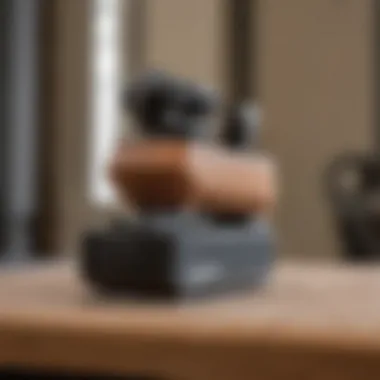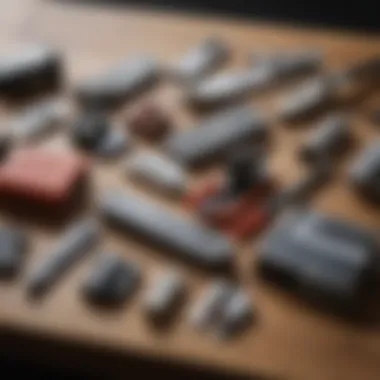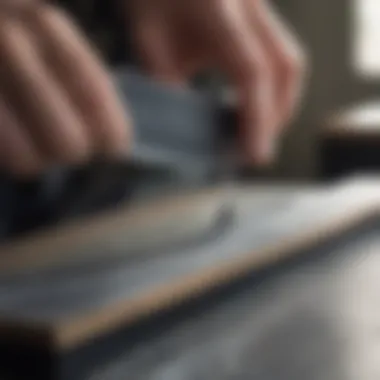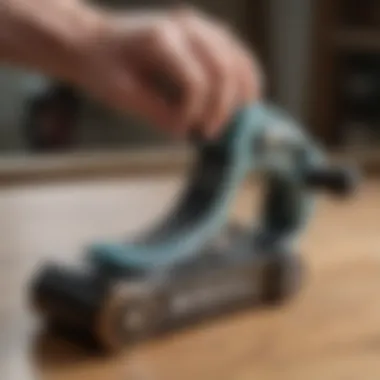Top Home Skate Sharpeners: Your Essential Guide


Intro
Skate sharpening is an overlooked but crucial part of any skater’s routine. Whether you're a casual skater just enjoying the ride or a competitive athlete pushing for high-performance, keeping your skates in tip-top shape is non-negotiable. A dull blade can ruin your control, speed, and overall fun on the ice. So, investing in a home skate sharpener may become one of the best decisions you make as a skater.
But with a plethora of options lined up on the market, how do you pick the right one tailored to your needs? This guide serves to navigate through the maze of skate sharpeners, providing insights that spare you from a purchasing faux pas. From different sharpening techniques to specific maintenance tips, you’ll gain the know-how for optimal performance. Here's a dive into some essential themes to untangle the complex web of choosing the right equipment.
Techniques and Skills
When it comes to skate sharpening, knowing the basic techniques can be a game changer. These not only benefit your skating performance but also increase the longevity of your blades.
Essential Tricks for Beginners
For those getting their feet wet in the world of skate sharpening, here are some fundamental tricks:
- Understanding the Basics: Before grabbing your sharpener, familiarize yourself with the anatomy of the blade. Know what a hollow is and how it affects your glide. Generally, oversimplifying the hollow concept can lead to serious misjudgment.
- Sharpening Process: Begin by checking the sharpness of your blades. Use your fingernail to feel for any nicks or dull spots. Then, follow the manufacturer's instructions to run the sharpener along the blade. It requires steady hands and a bit of practice, so don’t rush it!
- Testing Your Blades: After sharpening, test them on the ice. See how the skates perform and make adjustments next time you sharpen.
Advanced Techniques for Pros
For the seasoned skaters, the sharpening demands differ significantly. Here's what to keep in mind:
- Customized Hollows: Consider experimenting with different hollows; the more acute (deeper) the hollow, the more grip but less speed, while a shallow hollow gives the opposite. Finesse lies in finding your sweet spot.
- Blade Care: Proper maintenance doesn’t end at sharpening. Store your skates properly to avoid rust and edge damage. Consider using blade guards for additional protection when not in use.
“A dull blade is like skating on marbles; you won’t go far.”
- Regular Sharpening Schedules: Depending on your skating frequency and intensity, devise a sharpening schedule. Understand when the blades need a refresh based on your skating style and the surface you’re on.
The End
As you hone your skills in skate sharpening, remember that personal preference plays a vital role. Take note of your skating performance post-sharpening to make informed choices in the future. This guide aims to provide the insights needed for making an educated selection of home skate sharpeners. With the right techniques and maintenance, you’re well on your way to enhancing your skating journey. Keep those blades sharp, and enjoy the glide!
Understanding Skate Sharpening
Skate sharpening might seem like a simple chore on the surface, yet it plays a pivotal role in a skater's performance. Just like a chef relies on sharp knives, skaters depend on well-maintained blades to perform at their best. A deeper understanding of skate sharpening is crucial for skaters, whether they’re beginners or seasoned pros, as it bridges the gap between basic care and optimal performance on the ice.
The Importance of Regular Sharpening
Regular sharpening is akin to keeping a car’s engine well-maintained; it ensures everything runs smoothly. When skates lose their sharpness, skaters may struggle with control or feel unstable on the ice. Here’s why make it a habit:
- Performance Enhancement: The sharper the blade, the better the edge holds during turns and stops. Regular sharpening provides better performance and enhances your agility.
- Safety: Dull blades can lead to slips and falls, risking injury. Staying on top of sharpening means reduced danger while skating.
- Longevity of Equipment: Consistent maintenance can extend the life of the blades. Just like changing the oil in a car can prevent costly engine repairs, frequent sharpening keeps the edges healthy.
Think of it this way: when you feel confident in your gear, you skate more freely, enjoying every moment on the ice.
How Skate Sharpeners Work
Skate sharpeners function on a pretty straightforward principle. They remove material from the blade to create a fresh edge, which is sometimes referred to as a "honed edge." The process involves a few key elements:
- Ski Types: : Different skates work with specific sharpening techniques. Hockey skates, figure skates, and recreational skates may all need varied angles and precision.
- Grinding Wheel: Most sharpeners use grinding wheels, which can vary in grit and hardness. The choice of wheel impacts the finish and sharpness, with finer wheels delivering a smoother edge.
- Angle Settings: Sharpeners allow users to set their preferred angle. A 1/2-inch hollow is popular for hockey skaters wanting speed, while figure skaters typically opt for a flatter angle for controlled edges.


Understanding the mechanics of your sharpener can drastically improve your sharpening outcomes. Knowing how to adjust angles or which wheel is best for your skates can make a big difference.
In summary, the art and science of skate sharpening aren’t one-size-fits-all. Recognizing how these tools operate not only helps skaters maintain their equipment but also empowers them to choose the right sharpener for their skating style and needs.
Types of Skate Sharpeners
When it comes to keeping your skates in top-notch condition, the type of sharpener you choose plays a crucial role. The landscape of skate sharpeners can be divided into various categories—each with its own set of benefits and uses. Understanding these differences is essential for skaters looking to enhance performance, prolong equipment life, and make the most of their sharpening sessions.
Manual vs. Electric Sharpeners
Manual and electric sharpeners are the two predominant types of on the market, and each has its own distinct advantages.
- Manual Sharpeners: These are often simpler in design and rely on the user's physical effort. They can be quite effective for those who prefer hands-on involvement. Users often get a feel for the blade, making it easier to judge the sharpness and adjust technique accordingly. A manual sharpener, such as the Hockey Puck Sharpener, can be great for skaters who want complete control over their sharpening process. Moreover, they tend to be more portable and generally less expensive compared to electric options. The less complex mechanism also means they can last a long time if maintained properly.
- Electric Sharpeners: On the flip side, electric sharpeners provide convenience and speed. Devices like the Hollow Grinding 9000 can sharp blades in a matter of minutes, making them appealing for those who may need frequent sharpenings. Electric models usually feature adjustable settings that allow for various sharpening profiles, catering to different preferences. However, they come at a higher price point and require access to power sources. Additionally, users might need to invest more time in understanding the operations and settings to get the results they want.
"Choosing between manual and electric sharpeners is not just about preference; it’s about understanding your skating style and how often you need to sharpen your blades."
Fixed vs. Portable Models
Selecting between fixed and portable skate sharpeners also warrants consideration. It's not just about what’s more convenient—it’s about how you use your skates.
- Fixed Models: These sharpeners are typically designed for use at home or in pro shops. Models like the Ziggy Sharp are equipped to handle regular blade sharpening and tend to offer more comprehensive features, allowing for different sharpening angles and profiles. For serious skaters or those who compete, a fixed sharpener can be an investment that pays off in better performance. However, due to their size and need for setup, they aren't exactly travel-friendly.
- Portable Models: In contrast, portable sharpeners are game-changers for skaters on the go. Something like the On-The-Go Sharpener fits neatly into your bag and can be used almost anywhere. They are especially useful for skaters who travel frequently or play in multiple venues. Though they may not provide the same level of precision as fixed models, the convenience can be invaluable.
Ultimately, the decision between fixed and portable sharpeners hinges on your skating habits—how often, where, and in what conditions you skate .
Key Features to Consider
When on the hunt for the perfect home skate sharpener, one can’t just pick the flashiest model off the shelf. There’s a whole lot more to it than that. Understanding the key features of different sharpeners ensures that you settle on a device tailored to your specific skating style, frequency of use, and personal preferences. This section breaks down important elements you should focus on, such as sharpening options, durability, and ease of operation.
Sharpening Options and Adjustability
A big part of selecting the right sharpener revolves around the sharpening options available. Not all skaters are created equal; some prefer a finer edge on their blades for more control during tight turns, while others seek a more rounded edge for smoother glides. Many modern skate sharpeners provide a range of adjustable settings that allow users to dial in their desired edge profile easily.
Some sharpeners offer interchangeable parts for different sharpening angles. For instance, if you switch from ice to roller skating, having the option to customize your sharpness can be a game-changer. Check for features like:
- Multi-angle settings: Lets you pick your edge profile.
- Compatible grinding wheels: Some machines can work with various wheels, allowing more options.
These adjustments can greatly impact performance on the rink, so don’t overlook this feature when browsing your options!
Durability and Build Quality
Durability should never be sidelined when considering a skate sharpener. A good sharpener is an investment, and you want it to last more than just a season or two. Look for models made from high-quality materials that withstand regular use without breaking down.
There’s been a lot of talk among skaters about how the construction affects performance. For example, sharpeners built with metallic casings rather than plastic will generally hold up better over time. Here’s what to keep an eye out for:
- Material quality: Stainless steel parts last longer and resist corrosion.
- Weight and stability: A heavier sharpener is less likely to shift during use compared to a lightweight one.
Investing in a sharpener with solid build quality means less maintenance and fewer replacements in the long run.
Ease of Use and Maintenance


Let’s face it; not everyone is a tinkerer. Some skaters just want to hit the ice without fussing too much about equipment upkeep. This is where ease of use comes into play. Ideally, you want a sharpener that requires minimal setup and is intuitive to operate. If it takes more than a couple of tries to figure out how to get it running, it might be worth looking for something else.
Furthermore, you’ll want to think about maintenance. A sharpener that necessitates constant fiddling won’t win any favors. Here are a few elements that contribute to overall usability:
- User-friendly design: Control panels and indicators that are easy to interpret.
- Cleaning ease: Sharpeners that allow for quick access to parts for cleaning will save you from a world of headaches.
Having a machine that’s simple to operate and maintain can make all the difference in maximizing your time on the ice instead of in your workshop.
"Choosing the right skate sharpener isn’t just about sharpness; it’s about the entire sharpening experience."
Considering these key features ensures that you’re not just throwing money away on another piece of equipment that doesn't meet your needs.
Top Home Skate Sharpeners Reviewed
In the world of skate sharpening, the choices can seem endless. Understanding which home skate sharpeners stand out involves diving into the nitty-gritty of what each model delivers. This section is crucial for skaters, hobbyists, and instructors aiming to ensure optimal performance on the ice or at the skate park. The right sharpener doesn’t just keep your blades in top-notch condition; it can significantly enhance your overall skating experience.
Electric Sharpeners
Electric sharpeners have gained popularity due to their efficiency and precision. These machines take the hassle out of sharpening while ensuring that the blade remains consistent in its edge. They are particularly appealing for those who skate frequently or at a competitive level, as they deliver quick results without sacrificing quality.
Features of Leading Models
Leading electric sharpeners often come equipped with several features that make them notable choices. One key characteristic is an adjustable sharpening angle, allowing skaters to customize their edges based on personal preference or specific conditions. This adaptability is particularly beneficial for competitive skaters who require tailored setups.
For example, a prominent model, the Harris Hockey Sharpener, offers a consistent sharpening process with a user-friendly interface. Another unique aspect is the built-in cooling system that prevents overheating during use, ensuring the integrity of the blade is maintained.
The advantages here are clear: faster sharpening times and precise adjustments lead to a more enjoyable experience on the ice. However, they often come with a higher price tag, which may not suit every budget.
Pros and Cons
When considering electric sharpeners, weighing the pros and cons is essential for making an informed decision. One of the main advantages is the speed and consistency of sharpening; skaters can complete the process in mere minutes. This is especially useful for those with a busy schedule or multiple pairs of skates to maintain.
However, it’s worth mentioning that electric models can be heavier and less portable, which may pose a problem for some users. Additionally, while the initial investment is significant, the long-term durability of these machines makes them a worthwhile choice for serious skaters, despite the potential drawbacks.
Manual Sharpeners
Manual sharpeners often appeal to those who appreciate a more hands-on approach. These devices allow for greater feel and control, essential for honing one’s technique. With a manual sharpener, skaters can engage in the fine art of sharpening at their own pace, which can be both a relaxing and rewarding experience.
Best Manual Options Available
Among the best manual sharpeners on the market is the ProSharp Mini Sharpener. This compact device is particularly appreciated for its portability and straightforward design. Skaters can easily carry it in a bag without adding bulk. The standout feature of this sharpener is its dual-edge capability, allowing users to switch between different blade types conveniently.
This flexibility is favorable, as different skating scenarios may require varying levels of edge sharpness. An advantage of manual sharpeners like this one is often their lower price point, making it accessible to a wider audience.
User Experience Insights
User experience with manual sharpeners can vary significantly based on skill level and method of use. Many users find satisfaction in the tactile feedback provided when sharpening, claiming it allows them to refine their own edge preference.
Moreover, as these sharpeners typically require more effort, dedicated skaters often develop better sharpening techniques over time, translating to improved performance on the ice. The downside, however, is the longer time taken to achieve the desired sharpness, which might not suit everyone’s needs in a fast-paced environment.
Overall, manual sharpeners cultivate a sense of craftsmanship in sharpening, appealing to skaters who take pride in maintaining their equipment.
In summary, the diverse features and characteristics of electric and manual sharpeners cater to various preferences within the skating community. Whether speed and convenience are your priorities or the craftsmanship of manual sharpening attracts you, understanding these facets is crucial to enhancing your skating journey.
Maintaining Your Skate Sharpener
Taking care of your skate sharpener is as crucial as maintaining your skates. A well-maintained sharpener not only enhances your sharpening performance but also prolongs the lifespan of the device itself. Simple cleaning routines and proper care can save you from potential headaches down the line. After all, a dull blade can lead to frustrating performance on the ice, so let’s dive into how you can keep your sharpening tool in peak condition.
Cleaning and Caring Tips


Keeping your sharpener clean is vital for smooth operation. Here are some handy tips to consider:
- Regular Wipe Down: After every use, take a moment to wipe the sharpening wheel with a clean, dry cloth. Dust and metal shavings can accumulate quickly, affecting sharpness and leading to uneven edges.
- Deep Cleaning Occasionally: Depending on frequency of use, schedule a deep clean every few weeks. Use a soft brush to gently remove debris from hard-to-reach areas. For electric sharpeners, consult the instruction manual for specific cleaning procedures.
- Check Alignment: Sometimes sharper edges can come from improper alignment. Make sure that the skate blades are properly aligned in the sharpener. Misalignment could lead to a poor finish and an uneven edge which, in turn, can destabilize your skating.
- Lubrication: For manual sharpeners, a touch of lubricant can keep moving parts operating smoothly. Always consult the product manual for appropriate lubrication methods.
Taking these steps not only fosters a cleaner workspace, but it enhances your overall sharpening experience. Remember, "a clean shovel is a happy shovel," as the saying goes.
How Often to Sharpen
Knowing when to sharpen your skates is a balancing act that revolves around your skating style and the frequency of use.
- Look for Signs: As you skate, pay attention to how the blades feel on the ice. If you notice a decrease in grip or an increase in slipping, it's time to sharpen. An experienced skater can often tell when the blade has lost its edge.
- Set a Schedule: A common rule of thumb is to sharpen skates every 5 to 10 hours of ice time, but this can vary. If you’re hitting the rink daily, you might consider a sharpening routine every week or so.
- Environmental Factors: The type of ice you skate on also matters. If you skate on softer or slushier ice, you may find yourself needing to sharpen more frequently.
- Personal Preference: Competitive skaters often prefer sharper blades for better performance, whereas recreational skaters might wait longer between sharpening sessions.
Enhancing Your Sharpening Technique
When it comes to maintaining your skates, the sharpening technique can greatly influence your performance on the ice. Proper skills in sharpening go beyond just running the blade across a grinder. They encompass a deep understanding of your equipment, as well as the diverse conditions you might face while skating. You might think sharpening is a one-size-fits-all deal, but that's not the case. Tailoring your sharpening approach can lead to better control, speed, and edge retention, which ultimately benefits your skating experience.
In this section, we’ll cover common mistakes that many skaters make, and provide insights on how to achieve professional results right in your own home. Understanding these nuances could mean the difference between a great skating session and a frustrating one.
Common Mistakes to Avoid
Sharpening skates should be an art form; however, many skaters miss the mark due to a few prevalent mistakes. Here’s a rundown of some faux pas to steer clear of:
- Over-sharpening: It’s tempting to think that more sharpening equates to better performance. In reality, overdoing it can ruin the blade’s profile, leading to decreased control.
- Using the Wrong Angle: Each blade type may require specific angles for sharpening. Stick to the manufacturer's guidelines; otherwise, you might compromise the blade's shape.
- Ignoring Blade Condition: Sometimes, it’s about knowing when to sharpen. If your blades are nicked or dinged, that’s a red flag. Don’t just sharpen for the sake of it; assess the actual need.
- Forgetting Regular Maintenance: Regularly cleaning the blade and the sharpener increases the longevity of both. Dust and debris can affect edge sharpness, so it’s wise to keep things neat.
These pitfalls are easy to fall into, especially if you’re anxious to get back on the ice. Awareness here is key. Taking a moment to evaluate your technique can save you headaches later.
Getting Professional Results at Home
Transforming your home setup into a mini sharpenemnt workshop is not only possible but also rewarding. The right techniques and equipment can yield professional-grade results without the need for frequent trips to a pro shop. Here’s how to achieve sharpness that meets your standards:
- Study Your Blades: Familiarize yourself with the characteristics of your blades. Different styles might call for varied sharpening techniques, and understanding this is half the battle.
- Invest in Quality Tools: A quality skate sharpener goes a long way. Brands like The Blademaster or Tazz, for instance, offer models that give precise control over the sharpening process.
- Develop a Routine: Like anything else worth learning, sharpening is also about practice. Set aside time regularly to practice and tweak your technique. Familiarity breeds expertise.
- Use Visual Aids: Consider watching instructional videos or using guides to refine your skills. Sometimes, seeing an expert in action helps clarify your own method.
Once you nail down your technique, you’ll find yourself improving with each session. Having that confidence in your sharpened edges will enhance not only your performance but also your enjoyment out on the ice. Remember, a solid sharpen isn't just a luxury; it's fundamental to your skating experience.
Ending and Recommendations
In wrapping up our detailed analysis on home skate sharpeners, it’s crucial to emphasize how the right choice can significantly enhance your skating experience. Selecting a sharpener isn’t merely a matter of convenience; it directly impacts your blade’s performance, which, in turn, affects your agility and precision on the rink or ice. The aim here is not just to maintain your equipment but to elevate your skills to the next level.
Choosing the Right Sharpener for Your Needs
When it comes to choosing a sharpener, understanding your unique needs is paramount. Consider factors like your skill level, the type of skate you use, and how often you skate. A recreational skater may find that a manual sharpener suffices, allowing for light touch-ups between sharpening sessions. However, for more serious skaters—like those participating in competitive events—investing in an electric sharpener might prove beneficial. They deliver consistency and precision that is hard to achieve manually.
Moreover, think about the maintenance of your sharpener. Some models require more upkeep than others, which might influence what option fits best into your routine. For instance, if you're someone who prefers low maintenance, an electric sharpener with self-cleaning features could be a real lifesaver.
Key Considerations:
- Skill Level: Match the sharpener type to your skating frequency and ability.
- Skate Type: Ensure compatibility with your specific brand or model of skate.
- Usage: Evaluate whether you need a portable model or one that's fixed in a location.
"A sharp blade can make all the difference, transforming a good performance into a great one."
Final Thoughts on Skate Maintenance
Skate maintenance doesn't just end at sharpening. It’s about forming a habit that ensures your skates are always ready to defend your ambitions on the ice. Regular checks and maintenance will prolong the life of your equipment, saving you money down the line. Not only does it involve sharpening, but also examining the overall health of your blades, ensuring the edges are free of nicks or damage.
As you continue your skating journey, remember that the right maintenance routine goes hand-in-hand with an informed choice of sharpener. Whether it’s a manual model for hands-on enthusiasts or an electric one for those who value efficiency, your personal touch is what will ultimately connect you to your skating performance.







